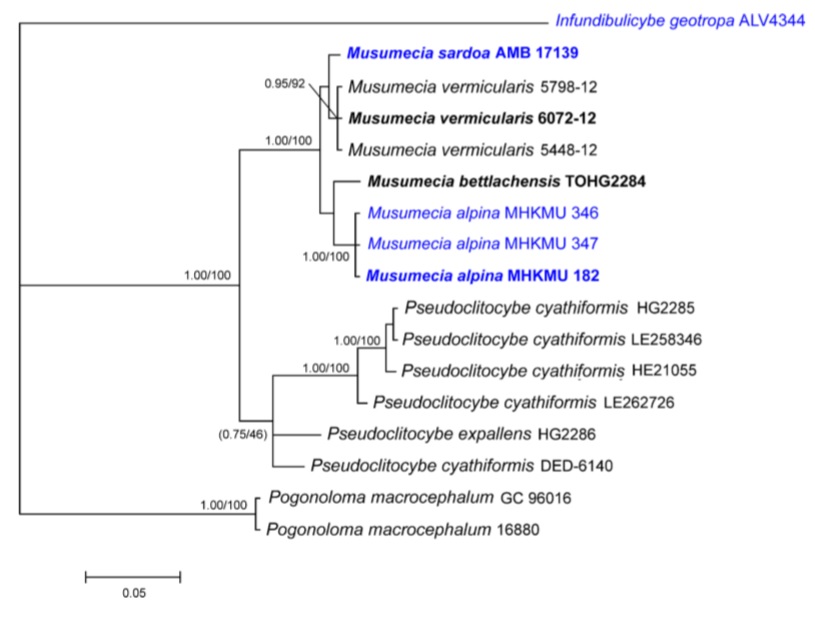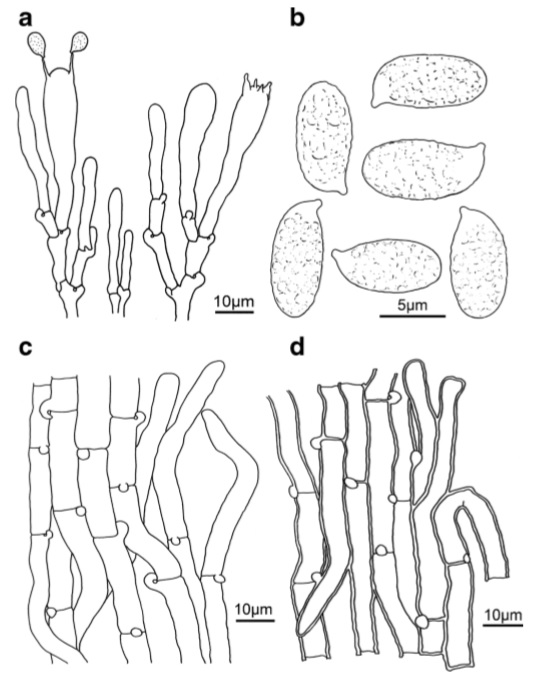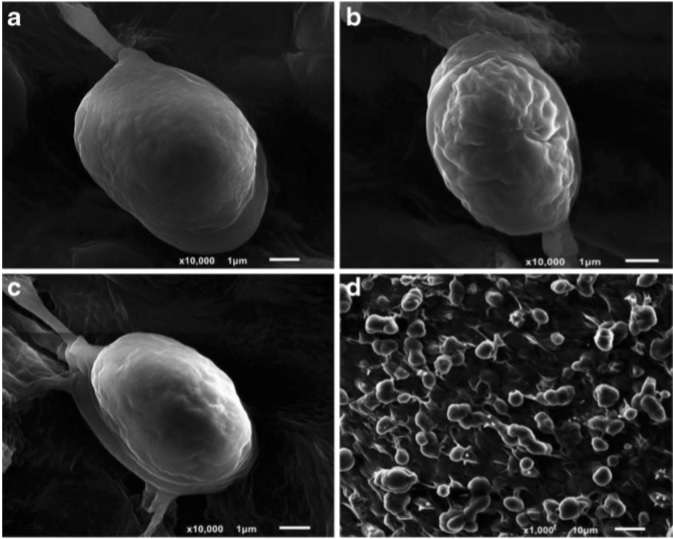Musumecia alpina L.P. Tang, J. Zhao & S.D. Yang
MycoBank number: MB 812873 Facesoffungi number: FoF 02046
Etymology: Derived from latinal pinus, relative to the Alps, in reference to their preference for mountain habitats.
Holotype: MHKMU 182 Colour codes follow Kornerup and Wanscher (1981).
Habit mycenoid. Pileus 3–4 cm in diam., applante or slightly depressed around umbo, dark grey (1E1-2, 4E1) to grey-black (4E2, 7E2, 8E2) over centre, paler towards the margin, greyish-black (1D3, 2D1–2) to greyish-white (2C2, 3C2), with a vague to evident, greyish to pale grey zone at margin;surface covered withdense tomentum or pubescence; margin slightly inflexed or involute, greyish-white (2B1, 3B1–2, 4B1); pileus context colour not changing when injured. Lamellae 0.4–0.6 cm in width, adnate, crowded to subdistant, sinuous, grey (3C1–2) to greyish white (1B1), interspersed with lamellulae. Stipe 5–7.5×0.5–0.6 cm, single, central attached to subcentral, subcylindrical to cylindrical, slightly narrowing upwards, greyish (3B1) to white (3A1); surface slightly smooth; base slightly enlarged, with whitish (2A1, 3A1) to white (1A1) mycelium or rhizomorphs; solid to loose when young, then fistulose; stipe context fibrous, consistent when handled, greyish-white (2B13, B1–2) to creamwhite or white (3A1, 2A1). Smell and taste faint, not distinct. Spores [80/4/3] (6.5–) 7.5–9( –10)×(3.5–)4 –5( –5.5) μm, Q=(1.35–) 1.58 –2.16 (–2.49), Qm=1.89±0.22, ellipsoid to oval, with a small apiculus, inamyloid, thin-walled, hyaline, colourless in KOH, densely covered with irregular rugulose ornaments (ornaments not clearly in KOH, but clearly observed in Cotton Blue and under SEM). Basidia 35–38×4– 5μm, clavate, hyaline, colourless in KOH, thin-walled, 2–4 spored, predominantly 2-spored, sterigmata6–8μm in length. Cheilocystidia and pleurocystidia clustered or scattered, quite similar in shape and size, 24–30×3–5μm, clavate, thin walled, hyaline, clamped. Hymenophoral trama composed of subparallel filamentous hyphae, 3–7μm wide, thin-walled, hyaline,colourlessinKOH.Pileipellismadeupofsubparallel filamentous hyphae, 6–8μm wide, thin-walled, hyaline, clamped. Stipitipellis composed of subparallel filamentous hyphae, 5–7μm in diametre, slightly thick-walled (up to 1μm), hyaline. Clamp-connections abundant in every part of basidioma.
Habitat and known distribution: Alpine mountain in southwestern China.
Material examined: CHINA, Yunnan Province, Eryuan County, Ma’an mountain, N 26°15′21.74″, E100°06 ′04.02″, alt. 3500 m asl, in broad leaved forest with Ericaceae (Rhododendron anthosphaerum, R. fictolacteum, andR. irrotatum subsp. irrotatum) andFagaceae (Quercus monimotricha), 22 August 2014, L.P. Tang 1778 (MHKMU 182, holotype). Yunnan Province, Eryuan County, Ma’an mountain, N 26°15′21.74″, E 100°06′04.02″, alt. 3560 m, in broad leaved forest with Ericaceae (Rhododendron anthosphaerum, R. fictolacteum, andR. irrotatum subsp. irrotatum) andFagaceae (Quercus monimotricha), 22 August 2014, S.D. Yang 89 (MHKMU 346). Ibid. S.D. Yang 90 (MHKMU 347).

Phylogenetic relationships of Musumecia based on ITS sequences data. Bayesian posterior probabilities (PP≥0.90) and RAxML bootstrap values (BP≥70 %) are shown above or below the branches. New taxa are in blue and ex-type specimens in bold

Musumecia alpina a, b Basidiomes from L.P. Tang 1778 (holotype) a Mature basidiomes with a tomentose-fibrillose to pubscent pileus b Clustered basidiomes with base enlarged stipe and white rhizomorphs at the base of stipes c, d Basidiomes from S.D. Yang 90 c Single basidiome d Basidiomes with grey-whitish, curving lamellae and hollow stipe. Scale bars=1cm

Musumecia alpina (holotype) a Basidia, cheilocystidia, and pleurocystidia b Spores c Pileipellis d Stipitipellis

